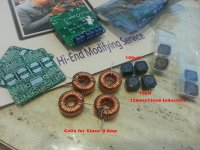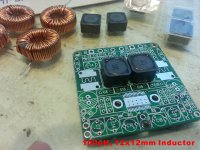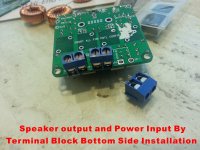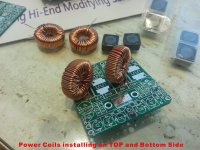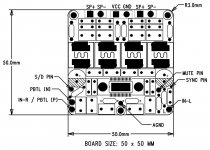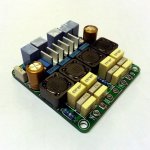Is this a new one?!
An externally hosted image should be here but it was not working when we last tested it.
Last edited:
I don't know why the turn on pop seems to be such an issue - in normal operation, one usually has inputs connected to a source. The simplest solution (since these draw such low amounts of power in idle) is to leave them on. I do not even have a power switch - they are hard wired from the SMPS brick and that is left plugged into the wall 24x7 - no more pop issues. When testing new speakers etc with the amps, I do unplug them but I always put a source connected to the inputs before powering on. Also, do not hot plug/unplug source with speakers connected and amp powered on. That is true for all amps.
I check my Ebay message box before I posted and I did not see anything.
If you have sent me reply, thank you.
Regards,
1) Available space under the bottom side to mount the terminal blocks for speaker and power connections.
Direct wires connections for input L/R signals, S/D, Sync, and Mute pin.
Note: Suggested direct wires connections, as best and minimize the contact resistance!
2) The inductor footprint size is up to 12x12mm with two TH for coils mount.
3) Yes, This board build-with Sync pin for extension boards connection. This is depended on your SMPS output power.
4) Amp Kit is available, The item number is 121294940702
Attachments
Buildmesomething,
I just setup my testbed for the dual YBDZ amps with the miniDSP 2x4 and am thinking of running the amps vertically integrated (each amp board drives treble and bass of either left or right channel). I wonder if there is any advantage of the more traditional horizontal integration (each amp board drives either treble OR bass and L&R). For quick prototyping I am securing the boards to a piece of foam core with a small hot melt glue dab in the corners of the PCB rather than using standoffs and screws. Haven't turned it on yet - had to leave for the dayjob before I could finish. Also, I am going to see how it fares with a single shared power supply for both boards - I will see if I get any of this power modulation beat frequency issue without syncing the mod frequency together. I wonder if vertical vs horizontal integration affects this?
Will probably get a miniDSP 2x4 to use specifically with the two YJ 2.0 blue boards.
I just setup my testbed for the dual YBDZ amps with the miniDSP 2x4 and am thinking of running the amps vertically integrated (each amp board drives treble and bass of either left or right channel). I wonder if there is any advantage of the more traditional horizontal integration (each amp board drives either treble OR bass and L&R). For quick prototyping I am securing the boards to a piece of foam core with a small hot melt glue dab in the corners of the PCB rather than using standoffs and screws. Haven't turned it on yet - had to leave for the dayjob before I could finish. Also, I am going to see how it fares with a single shared power supply for both boards - I will see if I get any of this power modulation beat frequency issue without syncing the mod frequency together. I wonder if vertical vs horizontal integration affects this?
Last edited:
1) Available space under the bottom side to mount the terminal blocks for speaker and power connections.
Direct wires connections for input L/R signals, S/D, Sync, and Mute pin.
Note: Suggested direct wires connections, as best and minimize the contact resistance!
2) The inductor footprint size is up to 12x12mm with two TH for coils mount.
3) Yes, This board build-with Sync pin for extension boards connection. This is depended on your SMPS output power.
4) Amp Kit is available, The item number is 121294940702
Very cool! A 50x50 mm implementation with thru-hole components where needed. What is the price?
These you mentioned are pretty primary causes for pop and hiss. You can add hiss by having too many trough hole components on a big board that has not been not properly designed. The wrong filter settings at the inputs can introduce pop at turn on or you can have that by leaving some pin connected / disconnected without the need of it being that way or connected to that path.The hiss/plop comes from an "open" amp with no source being connected/powered.
I have agreed with you about film caps for the inputs on my previous quote, they do sound better but it is a compromise and people should be aware that this is NOT a good idea to have big legged caps there as these will act like antennas. Well people have mentioned problems with the blue board, I don't see people here complaining about the green one and my experience is that it is much more reliable than the red YJ board. Maybe I have directed too much criticism about the things that are present in the design of the blue board ... Once mine arrives will let you know what I found about it.Sorry but you are talking the blue YJ board bad and the green board good. Just from the looks and theory ! Those parasitic inductances and capacitance are not always detrimental. I would rather have film caps for the inputs than SMD ceramic ones as they simply sound better.
Yeah, if these are common mode chokes then that's a bad thing... well, let's face it. Inductors are expensive and the Chinese made DIY boards have a long tradition of using less than OK / unsuitable inductors to cut costs. It is pretty common to have inductors saturating and getting hot, with a simple search like "inductors & hot" you will found that the majority of DIY Class D boards have less than optimal inductors.If it is right that the output coils are common mode types .....
*the uninsulated mounting holes are very interesting. I have seen quite some amps from China that have that. Just think what will happen if you use such an amp with an open frame SMPS (case always connected to PE) in one metal case.*[/QUOTE] You can easily solve that with shoulder washers or by simply cutting around the pcb mounting holes.
I would buy an improved blue YJ board with 4 mounting holes, anti thump and larger coils without blinking my eyes though
I think we might give a try at the hiamplifier board. I will IF he answer to my messages.
Is this a new one?!
An externally hosted image should be here but it was not working when we last tested it.
Looks new. I guess KJA needs to update the Cheat Sheet.
The link here seems to indicate that PBTL operation is possible.
TPA3116Êý×ÖС¹¦·Å°å12V ´ó¹¦ÂʳÉÆ·°å/´ø¿ª¹ØµçλÆ÷/²¢½Óµ¥ÉùµÀ-ÌÔ±¦Íø
1) Available space under the bottom side to mount the terminal blocks for speaker and power connections.
Direct wires connections for input L/R signals, S/D, Sync, and Mute pin.
Note: Suggested direct wires connections, as best and minimize the contact resistance!
2) The inductor footprint size is up to 12x12mm with two TH for coils mount.
3) Yes, This board build-with Sync pin for extension boards connection. This is depended on your SMPS output power.
4) Amp Kit is available, The item number is 121294940702
Man, I have sent you a bunch of messages now. Please, answer .
Thanks
Last edited:
Yeah, if these are common mode chokes then that's a bad thing... well, let's face it. Inductors are expensive and the Chinese made DIY boards have a long tradition of using less than OK / unsuitable inductors to cut costs. It is pretty common to have inductors saturating and getting hot, with a simple search like "inductors & hot" you will found that the majority of DIY Class D boards have less than optimal inductors.
I am not familiar with the inductor issues... sorry if this has been explained before.
How can you tell if it is a common mode inductor by looking at it? So if the inductor gets hot with normal operation, it is probably not the right type? Looking at the YBDZ board, is that a proper inductor? I also missed whether or not the 22 uH inductors are good as they are not 10 uH as spec'd by TI. I sometimes use 4 ohm speakers and other times 8 ohms. Are 22 uH best for 8 ohms and need 10 uH for 4 ohms?
well,just got a YJ blue/black board up and running.
Fed straight by an android nexus 7 with power amp app. Powered by Meanwell 15v 5a switching supply cranked up to about 17v or so-- according to my meter.
I have no skillsz whatsoever, I'm just a plug and play kind of person.
I have it hooked up near field on my desk with some Dayton b652s that have been braced and polyfilled along with added crossovers designed by Dennis Murphy.
So, played some Cars from laser disc FLAC, Bright Eyes FLAC from vinyl, Buckingham Nicks FLAC, and--right now--a 320k Hermano MP3.
So far, I am really pleased to say that this board and chip lives up to all the hype.
Completely blows doors off of the Lepai 2020, the Dayton DTA100a, the Sure 7492, and the Sure 7498
Plenty loud on my desktop.
Much better, clear sound. as everyone notes, better soundstage, better presence, acoustic stuff sounds good--especially the Lyndsey Buckingham acoustic guitars. Female vocals also sound great on the Bright Eyes stuff.
And even though its an MP3, the rock guitars really CRUNCH on the Hermano cut "Brother Bjork."
And, it's no slacker if I throw on a FLAC of Pink Floyd's "Time.
One thing I am hearing which I do not recall being audible with my other little amps is the old school rumble of the turntable needle on the vinyl during the really quiet passages.
Best $19 I have spent since finding out about class D 18 months ago.
I really appreciate all the expertise here and the knowledge. Would have never known about this --relatively--new chip and amp board without it. Nor would I have considered buying and hooking one up myself.
Fed straight by an android nexus 7 with power amp app. Powered by Meanwell 15v 5a switching supply cranked up to about 17v or so-- according to my meter.
I have no skillsz whatsoever, I'm just a plug and play kind of person.
I have it hooked up near field on my desk with some Dayton b652s that have been braced and polyfilled along with added crossovers designed by Dennis Murphy.
So, played some Cars from laser disc FLAC, Bright Eyes FLAC from vinyl, Buckingham Nicks FLAC, and--right now--a 320k Hermano MP3.
So far, I am really pleased to say that this board and chip lives up to all the hype.
Completely blows doors off of the Lepai 2020, the Dayton DTA100a, the Sure 7492, and the Sure 7498
Plenty loud on my desktop.
Much better, clear sound. as everyone notes, better soundstage, better presence, acoustic stuff sounds good--especially the Lyndsey Buckingham acoustic guitars. Female vocals also sound great on the Bright Eyes stuff.
And even though its an MP3, the rock guitars really CRUNCH on the Hermano cut "Brother Bjork."
And, it's no slacker if I throw on a FLAC of Pink Floyd's "Time.
One thing I am hearing which I do not recall being audible with my other little amps is the old school rumble of the turntable needle on the vinyl during the really quiet passages.
Best $19 I have spent since finding out about class D 18 months ago.
I really appreciate all the expertise here and the knowledge. Would have never known about this --relatively--new chip and amp board without it. Nor would I have considered buying and hooking one up myself.
Last edited:
I am not familiar with the inductor issues... sorry if this has been explained before.
How can you tell if it is a common mode inductor by looking at it? So if the inductor gets hot with normal operation, it is probably not the right type? Looking at the YBDZ board, is that a proper inductor? I also missed whether or not the 22 uH inductors are good as they are not 10 uH as spec'd by TI. I sometimes use 4 ohm speakers and other times 8 ohms. Are 22 uH best for 8 ohms and need 10 uH for 4 ohms?
To be honest with you inductors play a big hole in sound quality with class D amps and since these chinese boards always come with the wrong types/ bad quality types I always change them to micrometals t6x, wurth, tdk or whatever brand you like. I think an inductor that can handle 8A, at 1 Mhz plus, is enough or more than enough. To check If you need 22uH or 10uH inductors you need to check the rest of the filter components / your speakers you. You can have different values for inductors and caps but end up with the same filter. here you have a very nice calculator to sort things out
Alright, this thing sounds sweet.
I switched out the meanwell 15v 5a for the 24v 5a power brick supplied with the Dayton dta100a.
Cannot tell if that is a big difference or not.
Did this to save space on my desk.
Now I can run the amp in a Darth Vader valentine's day cchocolate candy tin.
Gonna order another one to learn how to mod!
I switched out the meanwell 15v 5a for the 24v 5a power brick supplied with the Dayton dta100a.
Cannot tell if that is a big difference or not.
Did this to save space on my desk.
Now I can run the amp in a Darth Vader valentine's day cchocolate candy tin.
Gonna order another one to learn how to mod!
IMHO good advice from ramp3.First, a TL;DR: forget about the YJ red boards and go for the greenies.
advice from yrk971I can highly recommend the Ybdz 2.0 board
I liked the 3110 but the red 3116 not so much. ( high notes piano and xylophone not as good ) Bought the green board and like it a lot. Ordered a second one.
I am not familiar with the inductor issues... sorry if this has been explained before.
How can you tell if it is a common mode inductor by looking at it? So if the inductor gets hot with normal operation, it is probably not the right type? Looking at the YBDZ board, is that a proper inductor? I also missed whether or not the 22 uH inductors are good as they are not 10 uH as spec'd by TI. I sometimes use 4 ohm speakers and other times 8 ohms. Are 22 uH best for 8 ohms and need 10 uH for 4 ohms?
Yeah this is the area that I need greater clarification on. Ti recommends 10uh/.68uf for 4-8ohms for the 3116 but it would be great to see an actual frequency response to graph to gauge the impact of the filters. I thought the TI Class-D pdf was accurate until Saturnus explained otherwise.
My 4 ohm speakers sound almost perfect with the stock filter but the very top end is still a little sharp. It would be nice to know if a small change in values can clear that up.
I liked the 3110 but the red 3116 not so much. ( high notes piano and xylophone not as good ) Bought the green board and like it a lot. Ordered a second one.
Which "Green board" are you referring to? Please use the KJA2013 cheat sheet:
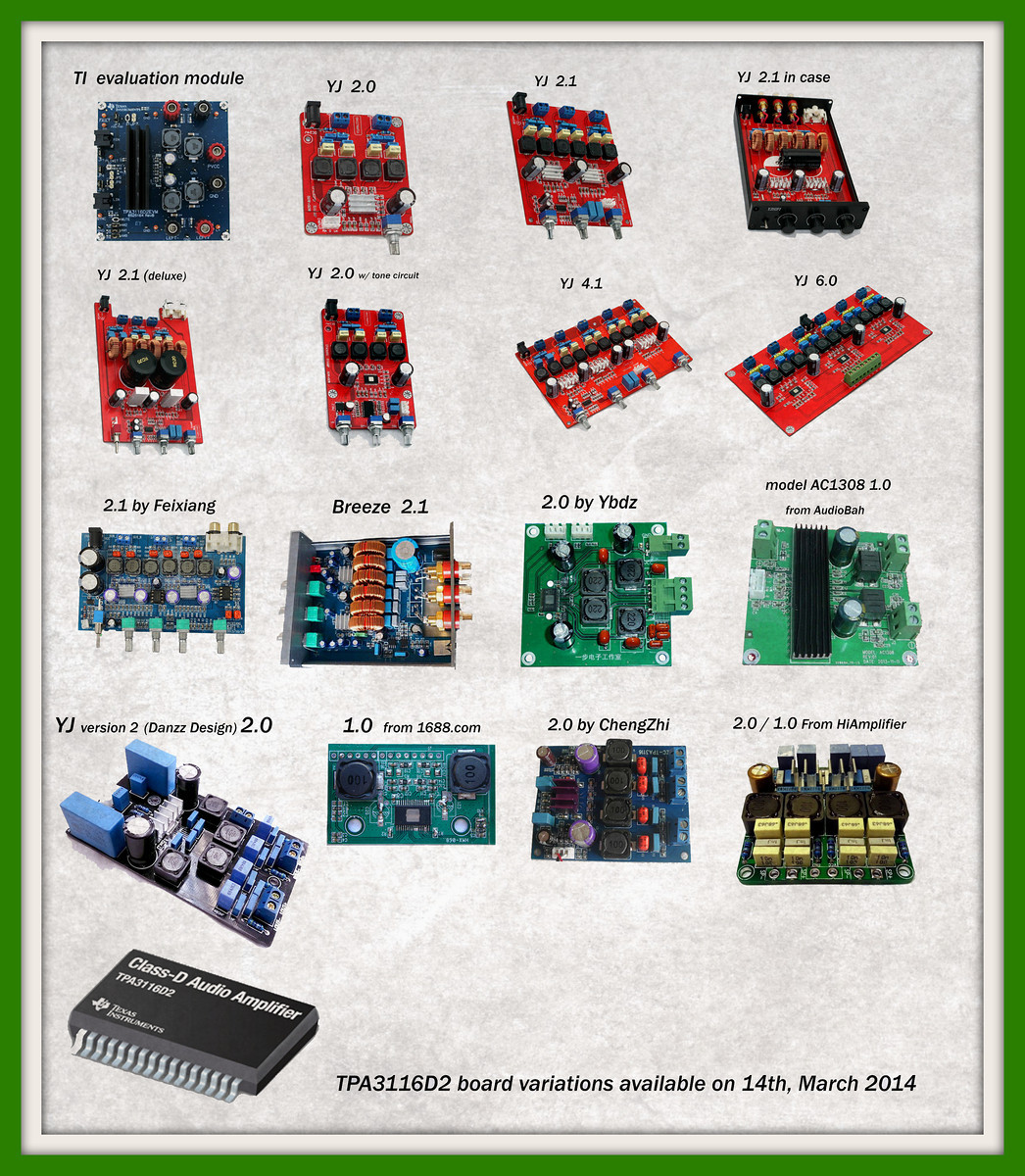
Interestingly, my YBDZ as deliverd is actually blue
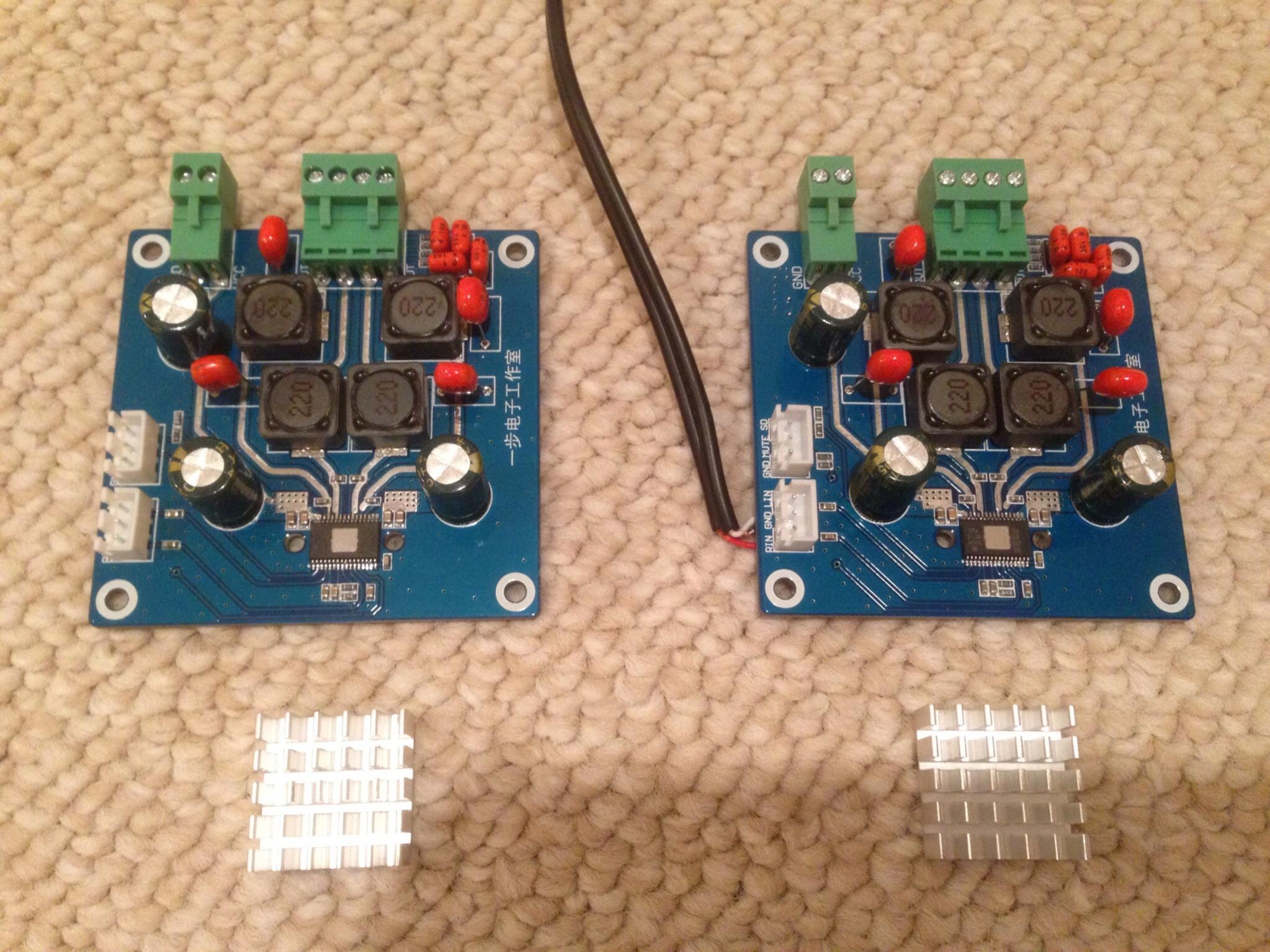
Which "Green board" are you referring to? Please use the KJA2013 cheat sheet:
2.0 Ybdz and mine is green.
Only if a board with ferrite beads comes on the market i will buy another one.
Last edited:
Going down memory lane, it seems like yesterday when I had my first taste of the 311xD2 sound from a dead bug flip chip amp. I pulled it out and listened to it in comparison to the latest offerings from China and my little amp holds it own! Still sounds great.
http://www.diyaudio.com/forums/class-d/219730-tpa3118d2-6.html#post3413886
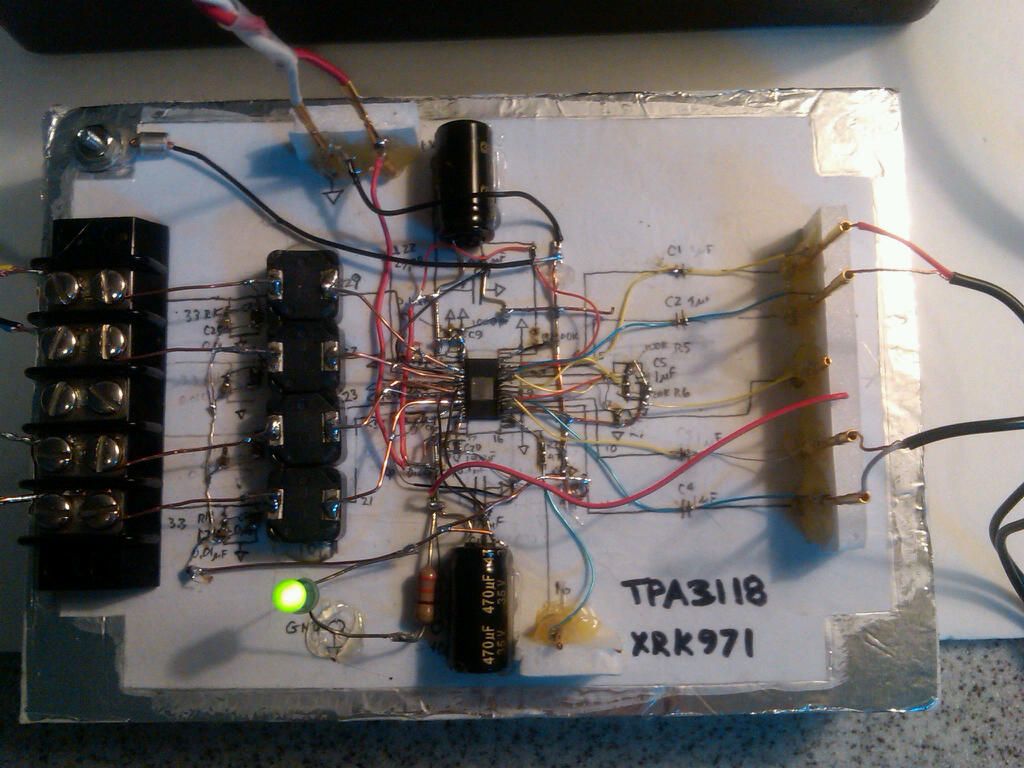
http://www.diyaudio.com/forums/class-d/219730-tpa3118d2-6.html#post3413886

Last edited:
Looks like there is a new variant of the 3116 in the bay. Comes with Bluetooth on board
1pc TPA3116 2 1CH 2 50W 100W Bluetooth Amplifier Board | eBay

1pc TPA3116 2 1CH 2 50W 100W Bluetooth Amplifier Board | eBay
X, sweet point to point build 
Will probably put mine into individual aluminium enclosures at some point... Having them properly grounded to the enclosure should help with the hiss. Plus, without a volume pot the amps output to the speaker is at 100%. I've set my YJ 2.0 blue boards to 20dB gain & should be getting >100dB SPL peak... not surprising I can hear some hiss...
Quickly tried the Master/Slave set-up, this made the turn-off transient [pop] worse on the slave unit, so gone back to running both in master mode.
Will probably put mine into individual aluminium enclosures at some point... Having them properly grounded to the enclosure should help with the hiss. Plus, without a volume pot the amps output to the speaker is at 100%. I've set my YJ 2.0 blue boards to 20dB gain & should be getting >100dB SPL peak... not surprising I can hear some hiss...
Quickly tried the Master/Slave set-up, this made the turn-off transient [pop] worse on the slave unit, so gone back to running both in master mode.
- Home
- Amplifiers
- Class D
- TPA3116D2 Amp
